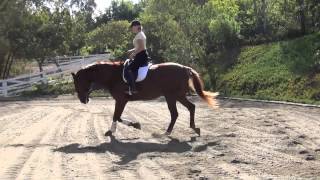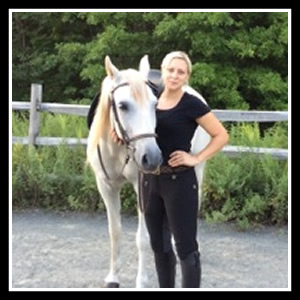Zoolander Canter

Good morning this is Will Faerber from Art2Ride and today we are giving you an update on Zoolander. Zoolander is our rescue horse that had been given to us because his owner was convinced that he was dangerous. What we discovered was that the horse was basically running away from pain: his saddle was killing him, his back was killing him and his feet were in terrible shape. That is the biggest thing that we have had to deal with for the last three months that we have had him is just getting his feet to the point where he is sound enough and comfortable enough on his feet to be able to be worked. You can find a video about our horseshoer Kenny Lyon and getting Zoolander straightened out in our videos.
Today we are going to show you where he is at now in his progress. As you can see in the video, he has become quite relaxed when this was a horse that the previous owners thought to be quite dangerous, when really he was just running away from pain. Now when he comes out he is probably the most relaxed horse in the barn and is pretty much wonderful about everything we do! He was not lunged today, he has gotten to the point where we just get on him and he immediately stretches to the ground and comes out beautifully and relaxed.
So now we are going to take a look at his trot work a little bit. You will notice that we are going to keep him in the stretch for the most part and we are getting much more length in his neck. This is a horse that had had his neck compressed back and had been broken in the neck as well. If he looks a little overbent at times, that is due to the fact that he had been overflexed in the neck and broken at the third vertebrae. We have to work very hard to straighten those things out, just letting the horse’s neck stretch out without taking a lot of contact until those ligaments and muscles begin to heal. She is going to keep him in a long frame where he is comfortable. If you compare this video to his earlier video you will see he is tracking up way more underneath himself now. Look how nicely he is working over his back now.
One of the questions that came in was “When is the horse ready to canter?” A horse is ready to canter when it can canter over it’s back, that is when it can canter and maintain the position of it’s back and is working through the back. Before then when you find that you can’t easily get that to happen, then you need to just work the trot. The trot is where we build muscle, the cantering usually builds wind. If your horse doesn’t have enough strength to canter correctly, then you’re going to do a lot more trot work to strengthen it and then come back to the canter. If you just canter endlessly, all you’ll end up with is a sore back on your horse. If he doesn’t have the strength to do it, he simply is not going to be able to and no amount of continuing to canter will do anything but hollow the horse more. You have to build (as we have done) the back of the horse as you can see in the video which has become quite nice!
We have only cantered this horse a few times since we’ve had him and certainly not in the last few weeks so we are going to try that now. As you can see he resisted there a little bit finding his place, but look how nicely he is now coming over his back with his muscles staying engaged over the topline. This tells me that this horse is now ready to begin more work in the canter. Why? Because he CAN canter. We have tried this many times before and we just go back to the trot and build the muscle, but now he has enough strength to be able to maintain it. Look how beautifully he swings through and how quiet and stable the rider is on top of him because his back is up with the weight carrying the rider forward, instead of sitting in a hole and being drug forward. Since that is his first canter in a while, that’s about enough and we will bring him back to a trot and let him stretch back after that beautiful ride. It might be a little rough in the transition there but not too bad. Now we are going to let him stretch right back out there to reward him, once again relieve the pressure on those muscles. Just like if you work out yourself you need to relieve that muscle, you don’t go to the gym and just keep one muscle tight the whole time, you can’t expect horses to do that either, you have to let them stretch back out to let the muscle flow again.
Now as we change direction we ask him to lengthen his stride across the diagonal to see if he is beginning to swing a little more there. She lets the trot get a little bigger and look how nicely he swings through. Now we will try the canter on the right lead. So once you get this idea of developing horses, rather than fighting with them or try and force them to do things, you realize how easy and much more fun riding can be when you understand that most resistance comes from lack of ability and muscular development. People always ask horses to do things they are incapable of doing, then they encounter resistance and a big fight ending up with a big problem on their hands. As you can see in the video he has an even better transition into the canter than the other direction. Look how nice and round he is staying over his topline and how relaxed and calm he is, beautiful!
The moral of the story here today is when your horse is ready it will do things quite easily if you prepare and develop them for the job you are going to ask them. If you are encountering a lot of resistance, chances are your horse is not ready to do what it is you are asking of him. We will show you one final stretch as he transitions back down to the trot. This time he makes the downward transition without any kind of change to his balance. She is going to let him stretch all the way down, beautiful! That is what we would like to see! If a horse has been developed correctly it will canter just like that, it will canter over it’s back.
This is Will Faerber from Art2Ride, my lovely wife Karen and our project horse Zoolander.
2 responses to “Zoolander Canter”
Leave a Reply
I absolutely love your videos! Very thoroughly explained. I’ve been working with my 13 year old QH for about a month and half in the stretch phase of the trot with some extension down the diagonal or long side. Last night I had cantered him and he just seemed to be stiff or resistant. After watching your video of Zoolander I had a question as to what your wife has does with her hands? Is it the same idea as beginning to teach a horse the stretchy trot? In other words, when he first cantered a few weeks ago did she raise her hands to maintain contact with his mouth or is he naturally carrying himself because of the muscles developed?





I absolutely love your videos! Very thoroughly explained. I’ve been working with my 13 year old QH for about a month and half in the stretch phase of the trot with some extension down the diagonal or long side. Last night I had cantered him and he just seemed to be stiff or resistant. After watching your video of Zoolander I had a question as to what your wife has does with her hands? Is it the same idea as beginning to teach a horse the stretchy trot? In other words, when he first cantered a few weeks ago did she raise her hands to maintain contact with his mouth or is he naturally carrying himself because of the muscles developed?
Hi Megan, Thanks for watching our videos and I’m glad they help. The answer to your question is, yes, she brought her hands up for a moment so that she could keep contact without him pulling up on the reins. That is exactly what you should do, if you keep your hands low when the horse tries to pull, it will make him even pull harder and throw his head higher against them. Never try to fight away the resistance in the canter as it usually means that the horse is not strong enough over his back to canter. Go back to the work in trot and build more muscle and then try the canter again in a week or so. It can take as long as a year to build the strength necessary so don’t be in a hurry, when it’s right the horse will canter correctly with no problem. Check it on the lunge line, if the horse is still having trouble there it will only be worse when you get on. Hope that helps.